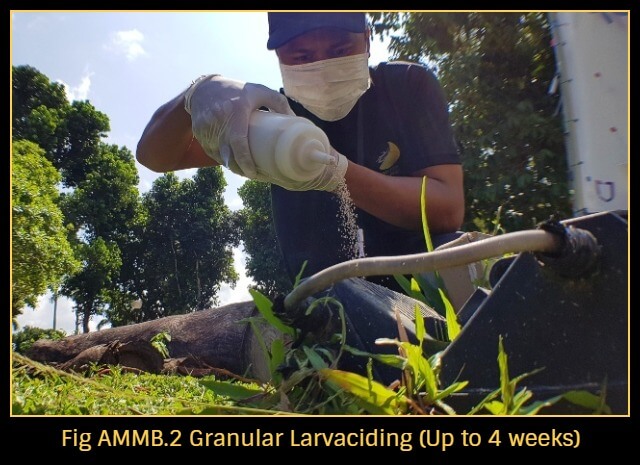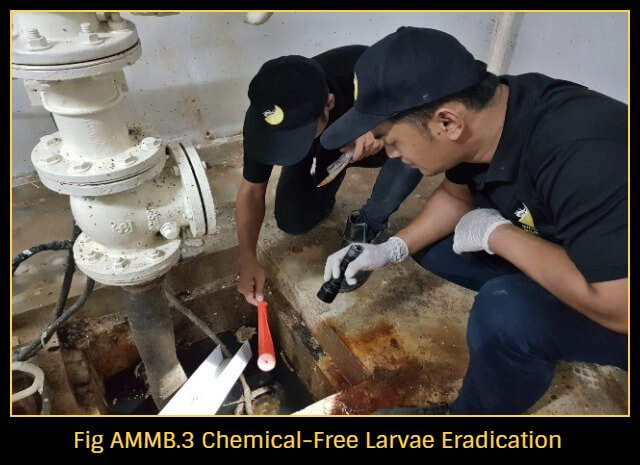Mosquito Control Singapore (The Mosquito Killer)
How to get rid of mosquitoes through Pesticon’s mozzie wipeout services?


Mosquito eradication and mosquito larvae elimination via mosquito fogging, misting and larvaciding: The use of a mosquito fogger to carry out fogging to kill mosquitoes, is a common practice in the industry. This age-old methodology in mosquito management has always been mislabelled as fumigation Singapore, and although useful is not without its limitations. When used with fogging oil, the resulting fog has an extremely strong smell, creates a thick column of smoke, and might stain the surrounding with its oily residue. With these in mind, thermal fogging for mosquito control is usually less suitable for areas with high human traffic. In a bid to overcome this and boost the performance of our anti mosquito fogging chemicals, water-based misting has been incorporated for our outdoor mosquito control. The use of such mist blowers allows for more variety of chemicals, with different formulations to be used. Such mist blowers are perfect for pesticides with long residual effects and form the backbone of Pesticon’s 3 in 1 mosquito protection program. With our program, we are confident that mosquito bites and the use of mosquito repellent will drop dramatically.


Pesticon’s 3 in 1 mosquito protection program
The gist of this program is to provide a unified protection, against adult mosquitoes and mosquito breeding through a single action of misting. Through the use of premium insecticides, we are able to;
1. Create a boundary with an extended period of protection.
2. Kill adult mosquitoes that are in the vicinity, when misting is being carried out.
3. Kill the larvae in water holding areas, when misting is being carried out.
Depending on the insecticide used, treated surfaces (for eg. foliage) coated by the insecticidal mist, will continue to kill adult mosquitoes for 4 – 8 weeks, when they land on all such surfaces.


Green and eco-friendly pest control
Apart from the use of mosquito spray, we also provide greener anti mosquito pest control services, by installing mosquito trap systems and dispensing BTI, both of which are larvicidal in nature.
What is BTI (Bacillus thuringiensis var. israelensis)?
BTI is a human safe, practically non-toxic and non-pathogenic biological control agent. In layman’s terms, BTI is a group of bacteria that kills the larvae of specific gnats, mosquitoes and flies. BTI when applied to water and eaten by the residing larvae, starts its journey being digested by the larvae’s midgut. The process of digestion releases delta-endotoxin from the BTI. The delta-endotoxin affects the larvae, by creating minute openings in the midgut membrane. All affected larvae soon stop feeding and die of starvation.
A look into the life of mosquito
There are mainly four stages in which the life cycle of a mosquito is divided into. Let us dive into the details of all these phases, to get a better idea about the biology of a mosquito.
Mosquito eggs
After a female mosquito feeds on human blood, she is ready to lay eggs in approx. 2 – 4 days. She can lay about 100 eggs after each full meal of blood and most of the eggs are able to survive for about 6 – 12 months.
Larva
The eggs will hatch into larvae in approx. 2 – 3 days. This phase consists of 4 stages of development. The first stage is known as the 1st instar. In this stage, the larva is nothing more than a little black dot floating on the water. At the 4th instar, the larva now spots a siphon or spiracles (species dependent) through which it breathes. In approx. 4 – 5 days, the larva will transform into a pupa.
Pupa
At this stage, the pupa doesn’t feed. It’s a stage where the pupa rests, to transform into a fully developed adult mosquito in 1 – 2 days. Even so, just like the larva, it can respond to external stimuli and moves by tumbling along. The larva, however, moves by wriggling through the water.
Adult
Adult mosquitoes can survive approximately 3 weeks in the natural environment. Both sexes feed on plant juices and nectar from flowers. Only the females feed on blood, as they require the pre-natal nourishment for the formation of their eggs.
Mosquito Diseases
We are all too familiar with the danger that Aedes Mosquito poses. Here in Singapore, Aedes Mosquitoes are the most notorious of all mosquitoes. Dengue Fever, Zika Virus and Chikungunya Virus are all transmitted, by infective female Aedes mosquitoes. The transmission of diseases by Aedes mosquitoes is such a concern, that NEA mosquito advisories, by NEA Singapore are being churned out on a regular basis, to provide a timely and informative guide to fellow Singaporeans.
Chikungunya (Chikungunya Singapore)
Both Aedes Albopictus and Aedes Aegypti are responsible for the transmission of Chikungunya. It is a kind of viral infection that can lead to joint pain, rashes, and fever. Unfortunately, there is no treatment for Chikungunya infection as of 2018. Symptoms are rather self-limiting and usually last approximately 2 – 3 days.
Dengue Fever (Dengue Fever Singapore)
Just like Chikungunya, Dengue Fever is transmitted by both the Aedes Aegypti and Aedes Albopictus mosquitoes. Dengue Fever is a viral disease, which in some cases produce no symptoms. In situations where symptoms were observed, they typically include headaches, nausea, vomiting, high fever, rashes and pain in joints. In severe cases, when Dengue Fever escalates to Dengue Haemorrhagic Fever, gum, mouth and nose bleeding can occur. Dengue vaccine is now available in Singapore.
Japanese Encephalitis
Japanese Encephalitis is a disease where the brain becomes infected, by the Japanese Encephalitis Virus. Such a virus is generally transmitted by Culex mosquitoes. It is a disease that has no specific treatment, and any treatment is generally palliative in nature. For those who survive the infection, recovery takes time, and in some cases, the damage is permanent. Japanese Encephalitis vaccine is now available in Singapore.
Malaria (Malaria Singapore)
Malaria is a life-threatening disease, caused by 4 species of parasitic protozoa from the Plasmodium genus. Female Anopheles mosquitoes are the only mosquitoes known for transmitting Malaria. A non-exhaustive list of symptoms includes fever, sweating, shaking chills, headache and nausea. Malaria can be effectively treated using malarial drugs. However, in some cases when the treatment is delayed, Malaria can become fatal.
West Nile Virus (West Nile Virus Singapore)
West Nile Virus is typically spread to humans, through mosquitoes that feed on the blood of infected birds. In most infection, symptoms were non-observable or minimal. However, for those seriously affected, fatality is 1 in every 10 patients.
Zika Virus (Zika Virus Singapore)
Zika is generally not as serious as Dengue Fever. However, infection from the Zika Virus can cause Microcephaly in a fraction of unborn foetuses. This is a congenital condition that shows up as a birth defect, where the affected babies are born with smaller heads as compared to the norm.
A non-exhaustive list of common mosquitoes in Singapore and their biology
Aedes Mosquito
Two common species of Aedes mosquitoes.
– Aedes Aegypti
Common name: Yellow Fever Mosquito
Physical appearance: An Aedes Aegypti mosquito is a charcoal coloured mosquito with prominent white bands on its legs. On top of its thorax, a bright silver lyre-shaped outline marks the scutum.
Biting habits: Usually 2 hours post-dawn and a few hours pre-dusk.
Breeding habitats: It prefers to breed in stagnant water that is clean. Man-made containers such as flower pots, vases, pails, canvas sheets, etc and natural water receptacle like tree holes, bamboo stumps, leaves axil, etc are common breeding grounds for Aedes Aegypti. Eggs are laid just above the waterline and they are likely to deposit their eggs over several sites. As compared to Aedes Albopictus, Aedes Aegypti shows a stronger preference for man-made containers.
Resting habits: Usually rests indoor in places that are cool and dark.
Disease transmission: Chikungunya Virus, Dengue Virus, West Nile Virus, Yellow Fever Virus and Zika Virus.
– Aedes Albopictus
Common name: Asian Tiger Mosquito
Physical appearance: As compared to Aedes Aegypti, Aedes Albopictus spots a darker shade of black and has a single bright silver stripe, running lengthwise, down the centre of the thorax.
Biting habits: Predominantly an outdoor and day biter. Usually early morning and late afternoon.
Breeding habitats: As compared to Aedes Aegypti, Aedes Albopictus shows a stronger preference for natural water-holding containers like bamboo stumps, coconut shells, pitcher plants, rock holes, etc.
Resting habits: Outdoor vegetation.
Disease transmission: Highly similar to Aedes Aegypti.
Culex Mosquito
Three common species of Culex mosquitoes.
– Culex Quinquefasciatus
Common name: Southern House Mosquito
Physical appearance: The Southern House Mosquito is a brownish midsize mosquito, with lightly coloured narrow bands around its abdomen.
Biting habits: Night biter.
Breeding habitat: Breeds in organically polluted and nutrient dense water like septic tanks, ground puddles and drains.
Resting habits: Mainly indoors with cool and dark environment.
Disease transmission: Lymphatic Filariasis, Japanese Encephalitis Virus, other viral diseases.
– Culex Gelidus
Common name: Frosty Mosquito
Physical appearance: Prominent pale frosty scales covers the thorax of the adult mosquito.
Biting habits: Usually an outdoor and night biter.
Breeding habitat: Ground depression and grassy puddle.
Resting habits: Mainly outdoor. For eg. Thickets & animal sheds.
Disease transmission: Important vector of Japanese Encephalitis Virus.
– Culex Tritaeniorhynchus
Common name: N/A
Physical appearance: A reddish-brown species with dark scale wing veins.
Biting habits: Usually an outdoor and night biter.
Breeding habitat: Low-lying water-logged areas, wells, ditches, ponds, water traps.
Resting habits: Almost similar to Culex Gelidus.
Disease transmission: Principal vector of Japanese Encephalitis Virus.
Anopheles Mosquito
Two common species of Anopheles mosquitoes.
– Anopheles Sundaicus
Biting habits: Both indoor & outdoor night biter.
Breeding habitat: Sunlit brackish lakes, mangrove swamp, fish ponds, prawn ponds & brackish containers (10 – 20% Salinity).
Resting habits: Both indoor & outdoor.
Disease transmission: A vector of Malaria.
– Anopheles Maculatus
Biting habits: Both indoor & outdoor night biter.
Breeding habitat: Hillside flowing stream & seepage water that is exposed to partial sunlight.
Resting habits: Both indoor & outdoor.
Disease transmission: A vector of Malaria.